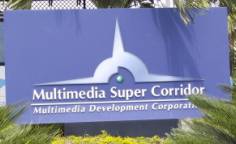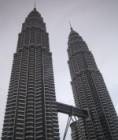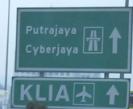Can a multi-ethnic, South East developing nation of 22 million leapfrog to a Knowledge Society?
It seems that practically anything in Malaysia to do with Information and Communication Technology (ICT) uses the word multimedia. For example, the ICT policy-maker is the Ministry of Energy, Communications and Multimedia; the Communications and Multimedia Commission (CMC) refers to the industry regulator; the Multimedia Super Corridor (MSC) is the country’s answer to Silicon Valley; and the Multimedia University is the nation’s ICT institute of higher education. This could easily be construed as over-hype, particularly as many governments are paying lip service to the Internet age but rarely back their public proclamations up with concrete actions. However something appears to be going on in Malaysia in its embrace of ICT as a lever to lift it to developed country status by the year 2020 (its so-called Vision 2020).
The Internet market is growing thanks to cheap tariffs, the introduction of broadband access, growing liberalization, rising awareness and a strong government commitment to ICT for development. The Malaysian Institute of Microelectronic Systems (MIMOS) <www.mimos.com.my>, launched the nation’s first Internet Service Provider (ISP) — Jaring www.jaring.my — to provide Internet access to Malaysian users. TMnet, the ISP of incumbent telephone operator, Telekom Malaysia, was the second, launching service in November 1996. Four other telecom infrastructure companies were licensed ISPs by early 2000. In July 2000, CMC introduced a new Internet licensing scheme with four types of licenses: Internet Access Service Provider (an ISP), Network Service Provider (provider of Internet infrastructure and bandwidth), Network Facilities Provider and End-Users Services. Four companies are Network Service Providers (Jaring, TMnet, Time Dot Com and Maxis Net) meaning they supply bandwidth for IASPs including themselves. ISPs (or IASPs in Malaysia) require a license from CMC that costs RM 2’500 a year.
TMNet is the largest ISP. It claimed around 700’000 subscribers in August 2000 for what it estimates to be between 65-70 per cent of the market.[1] This puts the size of the Internet subscriber market at just over one million. Figures on the estimated number of users diverge widely. One report predicts the number of Internet subscribers will be 1.5 million and the number of users 7.5 million by end 2000.[2] Yet the same report quotes a government official as stating that six per cent of Malaysians used the Internet in May 2000, or around 1.4 million people. A more realistic figure is probably somewhere between these two figures; perhaps 2.5 million users at June 2000, or just over one in ten Malaysians.
 The nation has an ambitious project to create a Malaysian “Silicon Valley”. Launched in 1996, the Multimedia Super Corridor (MSC) will stretch south from the largest city, Kuala Lumpur (KL), all the way to the new Kuala Lumpur International Airport (KLIA). The MSC is arising from a 15 kilometers long by 50 kilometers wide strip of land carved from a former palm tree plantation.[3] KLIA, completed in 1998, is futuristic, glass-enclosed and surrounded by rain-forest—maybe the world’s first eco-airport. So far only one phase has been completed. There are plans for two more terminals as demand rises. In fitting with its location at the tip of the MSC, the airport is so computerized that supposedly sales and inventory levels of all the shops it contains can be calculated within a day.
The nation has an ambitious project to create a Malaysian “Silicon Valley”. Launched in 1996, the Multimedia Super Corridor (MSC) will stretch south from the largest city, Kuala Lumpur (KL), all the way to the new Kuala Lumpur International Airport (KLIA). The MSC is arising from a 15 kilometers long by 50 kilometers wide strip of land carved from a former palm tree plantation.[3] KLIA, completed in 1998, is futuristic, glass-enclosed and surrounded by rain-forest—maybe the world’s first eco-airport. So far only one phase has been completed. There are plans for two more terminals as demand rises. In fitting with its location at the tip of the MSC, the airport is so computerized that supposedly sales and inventory levels of all the shops it contains can be calculated within a day. In addition to the airport, other landmarks include the Petronas Twin Towers (the world’s tallest twin towers) in southern KL, and the ‘intelligent cities’ of Putrajaya — the seat of the new federal government hosting government ministries and the Prime Minister’s residence — and Cyberjaya — the main town of the MSC.
In addition to the airport, other landmarks include the Petronas Twin Towers (the world’s tallest twin towers) in southern KL, and the ‘intelligent cities’ of Putrajaya — the seat of the new federal government hosting government ministries and the Prime Minister’s residence — and Cyberjaya — the main town of the MSC.The vision for the MSC is to create an oasis for Information Technology companies that will make Malaysia a multimedia hub and propel it into the hi-tech age. The government is providing a range of incentives to attract companies to the MSC. Over 350 companies had achieved the coveted MSC status.[4] Some 100 international companies including well-known heavyweights as Alcatel, Cable & Wireless, Ericsson, Fujitsu, IBM, Intel, Lotus, Lucent, Nokia, NTT, Oracle, Siemens and Sun have committed to the scheme. However few have yet to build their facility partly because of the sharp downturn in the Malaysian economy from the Asian financial crisis and partly because the underlying infrastructure — roads, fiber optic cable, etc. — is still being installed. One that has, is Japan’s NTT. Its MSC facility is NTT’s largest overseas Research and Development centre outside Silicon Valley.
Telekom Malaysia is hard at work installing the MSC communications infrastructure. The Asynchronous Transfer Mode (ATM) backbone has a 40 Gbps switch capacity. A variety of broadband customer access technologies will be offered including Fibre-to-the-Home, ADSL and high-speed wireless. Rapid national and international connectivity is assured through a 622 Mbps link to Telekom Malaysia’s domestic backbone and over 300 Mbps to the Internet backbone. Telekom Malaysia will guarantee quality of service, offer globally competitive tariffs and provide various complementary services such as web hosting.
 Located at the center of the MSC in Cyberjaya, the Multimedia University (MMU) is the first of its kind in the world. Focusing exclusively on a high-tech curriculum, the campus was built in 19 months and accepted its first students in 1997. There is also a sister campus in the city of Melaka. The two units already have some 9’000 students with a planned enrolment of 12’000 by 2002. There is a strong international flavor with students from 31 countries and faculty representing 23 nations. Students can enroll for undergraduate degrees in traditional subjects such as Electronics, Information Technology, Software Development, Data Communications and Engineering as well as more esoteric areas such as Entrepreneurship, Digital Media and Digital Art. And, in keeping with Malaysian fondness for the word, there is a Bachelors Degree in Multimedia. It is envisioned that MMU will play the same role that Stanford University does for Silicon Valley: a breeding ground for high-tech research and a steady supply of skilled techies for MSC businesses.
Located at the center of the MSC in Cyberjaya, the Multimedia University (MMU) is the first of its kind in the world. Focusing exclusively on a high-tech curriculum, the campus was built in 19 months and accepted its first students in 1997. There is also a sister campus in the city of Melaka. The two units already have some 9’000 students with a planned enrolment of 12’000 by 2002. There is a strong international flavor with students from 31 countries and faculty representing 23 nations. Students can enroll for undergraduate degrees in traditional subjects such as Electronics, Information Technology, Software Development, Data Communications and Engineering as well as more esoteric areas such as Entrepreneurship, Digital Media and Digital Art. And, in keeping with Malaysian fondness for the word, there is a Bachelors Degree in Multimedia. It is envisioned that MMU will play the same role that Stanford University does for Silicon Valley: a breeding ground for high-tech research and a steady supply of skilled techies for MSC businesses.What sets the MSC apart from similar schemes in other countries is its planning and scale. While other nations can boast of high-tech agglomerations such as Silicon Valley in the USA or Bangalore in Southern India, these grew piece mill, without much initial government support. In contrast, the MSC is the brainchild of the Malaysian government — which is offering numerous incentives for companies to settle there — and is underpinned by a three phase plan spanning some twenty years. And while many other governments are developing so-called technology parks, they pale in comparison to the size and scope of MSC.
MSC is the creation of a first-world environment in a developing country. In many ways, Malaysia is probably one of the few countries where this could happen. It is a unique developing nation with an unusual set of circumstances. Malaysia’s per capita income of some US$ 3’000 straddles it somewhere between the first and third. It is not quite as rich as Asian tigers such as Singapore, Hongkong, South Korea or Taiwan but neither is it as poor as other South East Asian developing nations such as Indonesia, Thailand or the Philippines. Nor is the government as cash-strapped as a typical developing country. And unlike advanced developed countries, where governments seemed to be ailing from sclerosis, the Malaysian government retains the lead role in driving economic development.
Table 1: Between first and third worlds
| Economy | Population (m) | GDP per capita US$ | Telephone lines per 100 inhabitants | Mobile subscribers per 100 inhabitants | Internet users per 100 inhabitants |
|---|---|---|---|---|---|
| Hongkong SAR | 7 | 24’612 | 57.6 | 63.6 | 32.7 |
| Singapore | 4 | 21’413 | 48.2 | 41.9 | 45.1 |
| Taiwan-China | 22 | 12’387 | 54.5 | 52.2 | 28.9 |
| Korea (Rep.) | 47 | 6’829 | 43.8 | 50.0 | 33.9 |
| Malaysia | 22 | 3’333 | 20.3 | 13.7 | 11.5 |
| Thailand | 61 | 1’859 | 8.6 | 3.8 | 1.6 |
| Philippines | 75 | 898 | 3.9 | 3.7 | 0.8 |
| China | 1’267 | 768 | 8.6 | 3.4 | 1.3 |
| Indonesia | 209 | 605 | 2.9 | 1.1 | 0.5 |
| India | 998 | 435 | 2.7 | 0.2 | 0.4 |
Source: ITU.
There are a number of programs to assist budding dot coms. These include R&D grants, incubation, training and venture capital financing. One hope is that world-renowned high tech companies will rub shoulders with Malaysia companies. This will help sharpen the skills of so-called Malaysian “technopreneurs”. Success should breed more success: as the number of companies grows, others will feel they cannot afford to be left out. It is hoped that international companies will establish their Asian headquarters at MSC, one reason for the closeness of the airport. In order to attract them, there will be wide-open spaces, efficient transportation options, and environmentally-friendly, high-tech housing — in short, first world living. As if that is not enough, there will also be a Disney-like theme park in the new e-Village. This planned content creation oasis will be where Hollywood meets Silicon Valley with the development of films, television and radio programming, interactive software and online publishing.
 It is too early to tell whether the MSC will be a revolutionary success or a colossal failure. Right now it is a huge construction site with mountains of dirt, hundreds of trucks, partially erected buildings and mazes of superhighway interchanges. The gut instinct is that there is something special going on here. The strong government leadership and dynamism of the Malaysian population suggest that this is going to work. Even at this early stage, the dedication and enthusiasm surrounding the project are infectious and leave many, particularly those from developing countries, in awe. After all, for someone from Nigeria or Trinidad, Silicon Valley seems irrelevant; a developed country phenomenon they just can’t relate to. But to see a fellow developing country build a high tech hub out of a tropical jungle, that sinks in. Indeed one emphasis of the MSC is to be a test-bed for appropriate, low-cost communications technologies suitable for developing countries.
It is too early to tell whether the MSC will be a revolutionary success or a colossal failure. Right now it is a huge construction site with mountains of dirt, hundreds of trucks, partially erected buildings and mazes of superhighway interchanges. The gut instinct is that there is something special going on here. The strong government leadership and dynamism of the Malaysian population suggest that this is going to work. Even at this early stage, the dedication and enthusiasm surrounding the project are infectious and leave many, particularly those from developing countries, in awe. After all, for someone from Nigeria or Trinidad, Silicon Valley seems irrelevant; a developed country phenomenon they just can’t relate to. But to see a fellow developing country build a high tech hub out of a tropical jungle, that sinks in. Indeed one emphasis of the MSC is to be a test-bed for appropriate, low-cost communications technologies suitable for developing countries.[1] It states that Internet subscribers grew by 9 per cent a month in the first half of 2000 and that Internet access revenues increased by 40 per cent in the same period. See Telekom Malaysia. “Telekom Malaysia Announces Half Year Results 2000”. Press Release. 29 August 2000.
[2] “Baby Steps For Our Net Generation.” Jaring Internet Magazine. May 2000.
[3] Malaysia is the world’s largest exporter of Palm Oil. In 1999 it produced 10.6 million tonnes of the product; export value was RM 19.5 billion. Source: Department of Statistics. “Key Statistics-Malaysia.”
[4] MSC status is conferred by the Multimedia Development Corporation, established to oversee the development of MSC. MSC-Status allows companies to benefit from a number of government initiatives including unrestricted employment of local and foreign workers, exception from foreign investment limits, 10 year tax holiday and no import duties.
See the Malaysia Case Study.

No comments:
Post a Comment